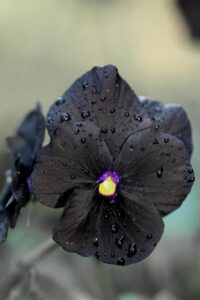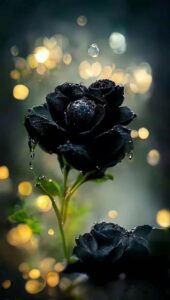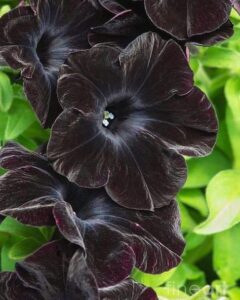The dark, velvety petals and striking yellow centers of the black pansy flowers give them distinctive blooms that are sure to turn heads.
Choosing a black pansy becomes an interesting decision because there are so many varieties waiting to be discovered!
Black Pansy Flower

Many gardeners and environment lovers are enthralled with black pansy blossoms. Amid a sea of garden blooms, they stand out because of their distinct shade and enigmatic appeal.
But what are these marvels of the dark hues? Black pansies aren’t black; rather, they’re a rich, deep purple or maroon that gives off an almost-black appearance, particularly in low light.
Their dark, velvety petals provide a striking visual treat when contrasted with the bright yellow cores common to many pansy types.
History Of Black Pansy Flower
The garden pansy (Viola × wittrockiana) has a fascinating history that traces back to England. Let’s explore its origins and development:
- Early Crossbreeding in England:
- The story of pansies began in Iver, Buckinghamshire, England, during the early 1800s.
- Lord Gambier and his gardener, William Thompson, were curious about creating new flower varieties.
- They experimented by crossing various Viola species, including V. tricolor, V. lutea, and a blue-flowered species (possibly of Russian origin), V. altaica .
- Hybridization and Domestication:
- These initial crosses led to the development of what we now call pansies.
- Over time, through careful hybridization and domestication, pansies acquired their striking variations in color and unique petal patterns.
- The result was a large-flowered hybrid plant known for its polychromatic beauty.
- Cultural Significance and Artistic Depictions:
- Pansies have captured the imagination of artists and writers alike.
- Vincent van Gogh painted “Mand met viooltjes” (Basket with Violets) in 1887, showcasing these delicate flowers.
- Georgia O’Keeffe also created paintings featuring pansies, including a black pansy titled “Pansy” in 1926 .
- Pansy Craze in the 1930s:
- During the late 1920s and 1930s, a period known as the “pansy craze,” sexually non-normative clubs and performers (referred to as “pansies”) gained popularity in the United States .
Types of Black Pansy Flowers
Black Moon

Description: Black Moon pansies feature near-black petals that surround a radiant yellow center.
Growth Habit: Trailing growth makes them ideal for hanging baskets, window boxes, or cascading over garden edges.
Appearance: The dark petals create a striking contrast against the bright yellow eye.
Use: Perfect for adding drama and elegance to your garden displays.
Black Velvet

Description: Black Velvet pansies are known for their rich hue and velvety texture.
Growth Habit: Compact and bushy, making them suitable for containers and mixed flower beds.
Appearance: The petals exhibit an iridescent quality, capturing attention.
Use: Plant them in groups or as focal points in your garden for a touch of sophistication.
Black Magic

Description: Black Magic pansies boast deep purple-black petals with a vibrant yellow center.
Growth Habit: Compact and tidy, great for small garden spaces or edging.
Appearance: The contrast between the dark petals and the yellow center is visually striking.
Use: Ideal for borders, rock gardens, or planting in clusters.
Black Pansy Care Tips
Here are some essential care tips to help your Black Pansy Flowers thrive:
- Planting Location
- Choose a spot with partial sun exposure. Black pansies prefer cooler temperatures.
- Ensure well-drained soil to prevent waterlogged roots.
- Planting Time
- Early spring or fall is ideal for planting pansies.
- Avoid extreme heat or frost.
- Watering
- Keep the soil consistently moist, but not waterlogged.
- Water at the base of the plant to prevent wetting the foliage.
- Deadheading
- Regularly remove faded or spent flowers (deadheading).
- This encourages continuous blooming.
- Fertilization
- Use a balanced, water-soluble fertilizer every 2-3 weeks.
- Follow package instructions for proper dilution.
- Mulching
- Apply a layer of organic mulch around the base of the plants.
- Mulch helps retain moisture and suppresses weeds.
- Pest and Disease Control
- Monitor for aphids, slugs, and snails.
- Treat any infestations promptly.
- Ensure good air circulation to prevent fungal diseases.
- Winter Care:
- In colder climates, protect pansies from severe frost.
- Cover them with straw or burlap during extreme cold spells.
Final Words
Flowers of the black pansy offer a beautiful touch to any landscape or garden. Their beautiful yellow centers and rich, velvety petals lend sophistication and beauty to any area.
Don’t forget to plant your black pansies in a spot with well-draining soil and partial sun.
Water them frequently, but watch out not to water them too much since this might cause root rot. To promote fresh growth, deadhead spent blooms and are treated sporadically with a balanced fertilizer.
Also Read: Enchanting Your Garden 10 Plants with Mysterious Black Flowers
